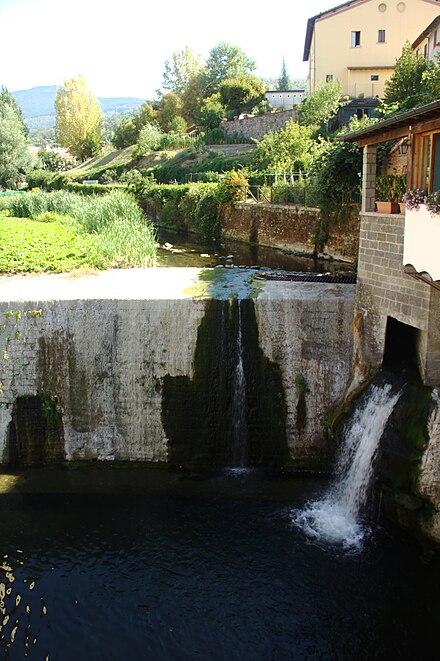Stia - Italian comune
Stia is a small town in Arezzo, in Tuscany, Italy.

Understand
Stia is on the western edge of the Casentenesi National Forest Park.
Stia grew up as the market place below the Guidi castle at Porciano. Presumably due to the topography, the piazza is not a normal square, but a more unusual triangular shape, sloping steeply at its far end. Today it is called Piazza Tanucci, after the Bernardo Tanucci, an Italian statesman, who was born in Stia in 1698.
Stia boasts a pair of covered arcades that run along either side of the piazza. They house a variety of shops, bars and restaurants. On entering the piazza from the lower end, the baroque facade of Santa Maria della Assunta dominates the left-hand side of the street.
Historically the Casentino was a fertile valley with various industries helping make the area prosper. Timber was important during the Medici period for shipbuilding, as was the woolen fabric, produced first to clothe the monks and nuns in the area, and then the wealthy families of Tuscany. 'Panno Casentino' used to be made with yarn spun by local women at home, and later was produced in modern cloth mills. At its height, the largest wool mill in Stia, built in 1838, employed over 500 people, and produced 700,000 metres of cloth a year. The factory is now a museum of wool production.
Get in
By car use road SS 556 or SS 310.
Get around
See

- Santa Maria della Assunta, Piazza Tanucci. The plain, 19th-century facade belies the fact that inside is a well-preserved Romanesque interior that is at least 600 older. The original church was built around 1150 for the Guidi Counts at Porciano, although a sacred site here was documented even earlier in 1017. The original facade was demolished in 1776, when the piazza was enlarged, and was rebuilt in the present Baroque style. Inside the sandstone columns are topped with capitals decorated with flora, animals and stylized people. The church also contains a glazed blue-and-white terracotta Madonna and Child; an example of the artist Andrea della Robbia's work. The campanile at the rear of the church has been altered several times over its history, with the current belfry and clock added in the 18th century.
- Wool museum (Museo dell'Arte della Lana di Stia), Via Sartori, 2 (follow river Arno upstream), +39 0575 582216, info@museodellartedellalana.it. Museum on wool in textiles in the old textile factory. It provides a historic bacground and displays many of the old machines. Also have workshops that produce textiles. €3

Do
Buy
Wool textiles or clothes.
- Tessilnova, Via Giovanni Sartori, 2/4, +39 0575 582685, info@tessilnova.com. M-F 09:30-13:00, 15:30-19:30, Sa Su 09:30-13:00, 15:30-20:00.

Eat
- Osteria del Caranbar, via Adamo Ricci, 19, +39 0575504500, +39 3491862889. Friendly service and great food. €10 for most courses
Drink
Sleep
- Albergo Falterona, Piazza B. Tanucci, 85, +39 0575-504569, info@albergofalterona.it. Friendly hotel with beautifully restored rooms (check the ceilings), computer with internet access in the lobby. €85
Connect
Go next
Stia
comune.stia.ar.itPostal code:52017Date Time:Please wait...Timezone:Europe/RomePopulation:2,990Coordinates:43.80, 11.71
Province of Arezzo
2nd-order administrative division
Tuscany
Primary administrative division